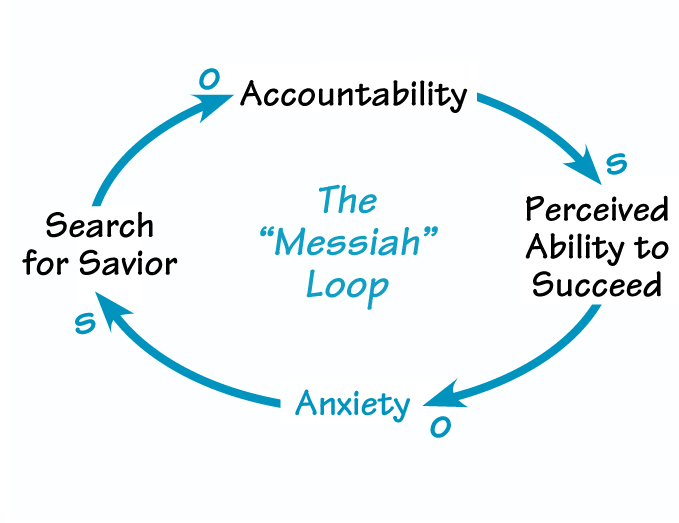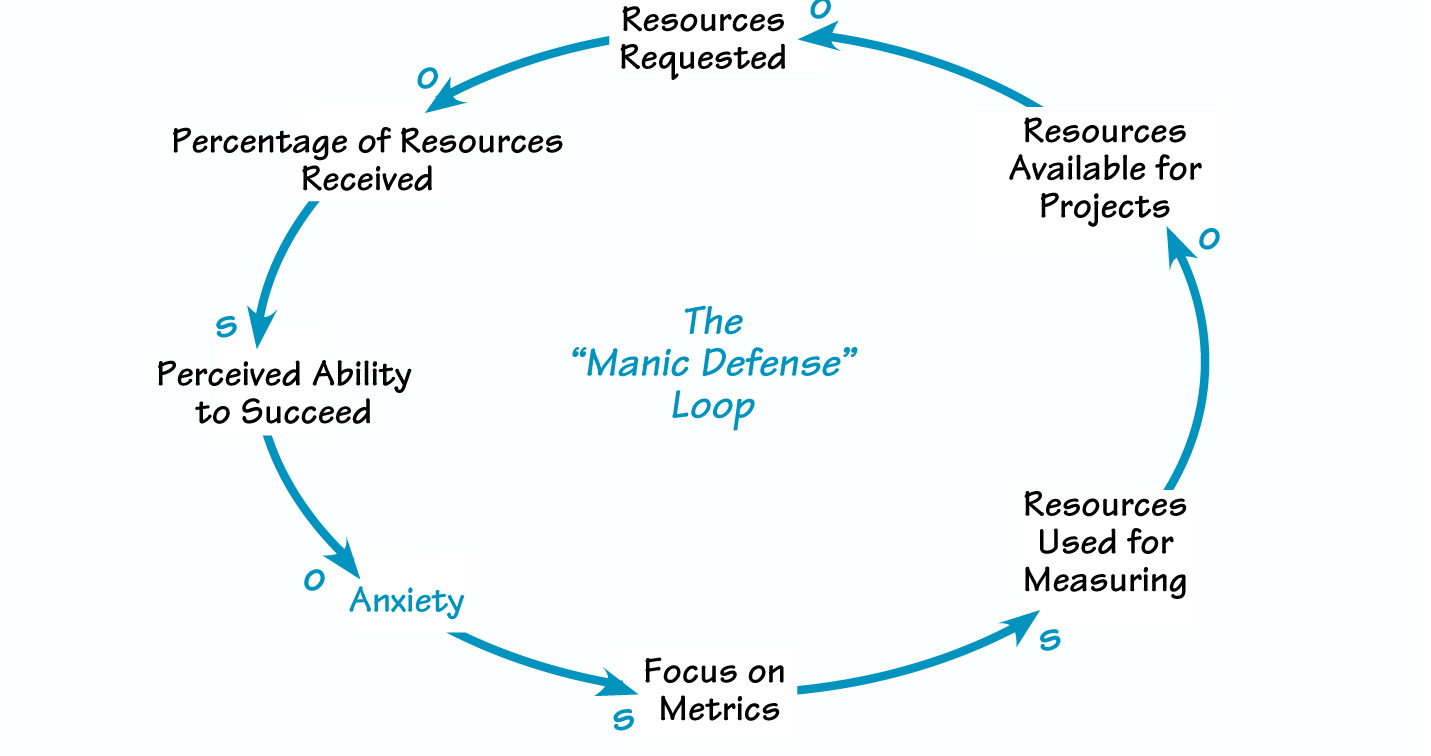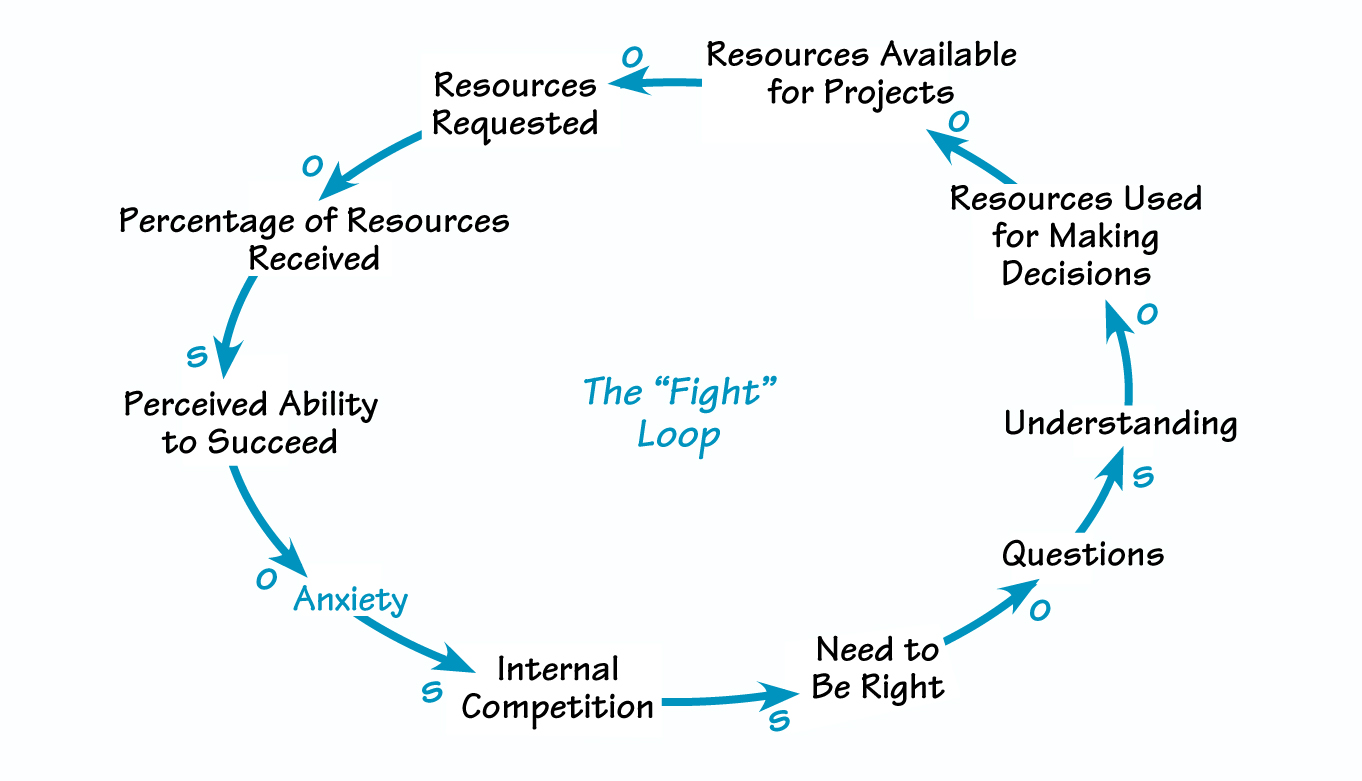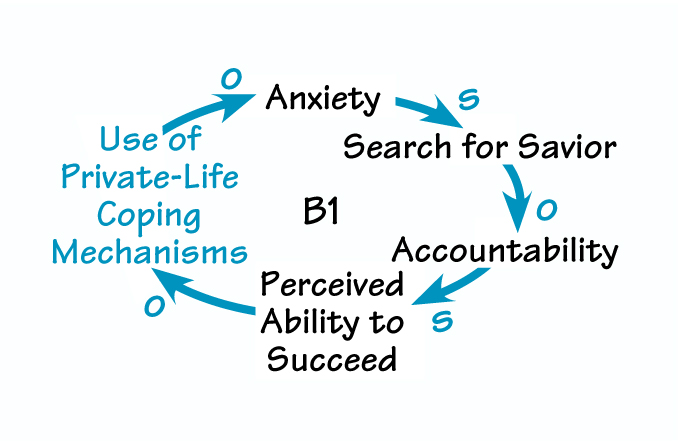Iam working sixty hours a week and don’t see an end in sight.” “If we don’t meet this quarter’s profit projections, heads will roll!” “I wonder when we’ll hear about the next round of downsizing?” If you or your colleagues have recently made or heard similar statements, your organization may be experiencing the symptoms of anxiety. Most of us have felt anxious at some point in our lives, especially when faced with immediate physical danger. But many people also know what it is like to live with feelings of fear or apprehension in their day-to-day work lives. With all the recent downsizing and rapid change in the business world, anxiety has become one of the more pressing problems plaguing us today.
What Is Organizational Anxiety?
Anxiety can be an insidious force: Not only does it sap energy levels and damage our health, it also eats away at job performance and stifles innovation and creativity. Like individuals, organizations can also suffer from symptoms of anxiety. Over the long run, anxiety can reduce an enterprise’s strategic adaptability and effectiveness.
In recent years, researchers have looked at anxiety from an intriguing new perspective. As they see it, the origin of anxiety is the struggle between life and death. This struggle that rages within individuals also takes place in work groups and organizations. Of course, organizations do not experience death in the same way that individuals do; however, they do face the very real possibility of financial or operational demise. Organizations can cease to exist through bankruptcy, takeover, mergers, and so forth. As a result, they experience their own brand of anxiety
Defenses Against Anxiety
Literature abounds on how work-groups and organizations try to cope with the destructive feelings of anxiety. According to one theory, some companies resort to a form of defense that combines three tactics called splitting, projection, and introjection that individuals often use to fend off anxiety. Splitting happens when we separate the “good” aspects of our lives from the “bad.” We then project “bad” qualities onto others and introject “good” qualities into ourselves. This tactic helps us to feel more in control of our panic, because we turn our attention to judging and trying to control others.
For example, an anxious manager might split good and bad by considering himself all-powerful (he introjects good into himself) while at the same time dismissing subordinates as unworthy (he projects bad onto others). Even worse, a manager in this frame of mind might be compelled to act on these projected feelings by punishing workers with extra work, impossible schedules, unreachable goals, and so forth. Companies tend to “institutionalize” this kind of behavior. Employees may quit and new ones may be hired, but the tough schedules and unattainable goals persist regardless of the individuals employed at any given time.
Groups or organizations that are leaderless can suffer more anxiety than most. For example, self-directed work teams may have difficulty making decisions if no leader steps forward. The team may become ineffective as it struggles to search for a leader, thus creating what can be paralyzing anxiety.
In these cases, the people involved often defend themselves against fearful emotions in three ways:
- Dependency. The group stops trying to solve its problems and instead waits for a “messiah” to save it.
- Pairing. Two individuals related to the group (for example, two group members, or one member and an outside consultant) combine to try to oust someone they consider a “bad” member.
- Flight/Fight. Group members blame all problems on an outside cause, or they pretend that no problem exists.
Defense mechanisms are neither good nor bad, and indeed can help protect us from emotional overload. But, the way these mechanisms are stitched together in an organization’s mental model can create the exact opposite of what the group wants and needs: Instead of reducing the anxiety, the behavior only worsens it. And mental models are notorious for leading to self-fulfilling prophecies: We see only what we expect to see, and then we act in ways that bring about results that confirm our assumptions.
When anxiety lodges itself in a company’s collective mental model of how things work, it will continue to perpetuate itself until the organization’s behavior changes to balance or reduce the increasing anxiety. For example, many organizations pride themselves on their “heroic” acts. When crises strike, creating high levels of anxiety, a few heroes step forward to “save the day.” The organization rewards the heroes. At the same time, by giving rewards, the organization inadvertently encourages the creation of future crises, which will lead to more anxiety and then to additional rewards for heroic action. This behavior is a perfect example of self-perpetuating anxiety.
Anxiety Amplified
Defensive actions can trigger reinforcing processes that serve to amplify and perpetuate anxiety. Here are examples of three reinforcing loops that can sustain or even worsen anxiety in organizations. Although these loops were created by a work group at a large company, they reflect dynamics experienced by many organizations.
The “Messiah” Loop. In this dynamic, if Anxiety about the organization’s performance intensifies, employees look for a “messiah”(Search for Savior). This search diminishes workers’ Accountability, in turn reducing their Perceived Ability to Succeed. The diminishing of workers’ self-esteem then leads to an increase in Anxiety.
The loop contains a bitter irony: The group searches for a savior to ease its anxiety, but waiting for a “messiah” only leads to more anxiety. The team could design a more fundamental, enduring solution to their anxiety by focusing instead on learning and performing. Sadly, however, the “quick fix” of seeking a savior diminishes the organization’s need for—and thus its ability to apply—a more fundamental solution.
THE “MESSIAH” LOOP

if Anxiety about the organization’s performance intensifies, employees Search for a Savior. This search diminishes workers’ Accountability, in turn reducing their Perceived Ability to Succeed and increasing Anxiety.
The “Manic Defense” Loop. In this reinforcing process, anxious managers project the organization’s problems onto their subordinates and then try to punish them. To justify this punishment, the managers focus obsessively on quantitative measurements, slavishly using them to control the action around them. Through this emphasis on metrics, the managers deplete the organization of the physical, financial, and—perhaps most important—psychological resources the team members need to succeed. All of this ultimately leads to even more intense anxiety.
In the “Manic Defense” loop, increased Anxiety leads to more Focus on Metrics, which in turn causes Resources Used for Measuring to go up. As Resources Used for measuring rises, Resources Available for Projects diminishes, which in turn increases Resources Requested. The diminished resource base for projects puts added pressure on those trying to complete projects. The project manager then requests more resources in order to complete the projects. As Resources Requested increases, Percentage of Resources Received is reduced because of the multiple demands on the system created by the additional resources requested for measurement.
This development further cuts into Perceived Ability to Succeed and ultimately heightens Anxiety.
The “Fight” Loop. We call the third reinforcing process the “Fight” loop because it captures the way anxiety sparks conflict within the team and encourages an aggressive desire to have one’s own viewpoints and decisions prevail. Increased Anxiety leads to increased Internal Competition, which leads to a greater Need to Be Right. Intensifying the Need to Be Right reduces the level of inquiry (Questions), which also lowers Understanding and increases the Resources Used for Making Decisions. More employee time and energy is needed to make decisions when there is little understanding of the issues facing the organization. The rest of the loop follows the “Manic Defense” loop, ultimately creating even more Anxiety.
THE “MANIC DEFENSE” LOOP

Understanding Our Own Role
As we look at the three reinforcing loops, we can begin to see how team members themselves might create and intensify their own anxiety. Often, factors viewed as external causes for anxiety, such as perceptions of failure or layoffs, could really be internally driven. To surface these factors, we might ask, “Who is perceiving this failure—our own organization, stockholders, or customers?” If it is our own organization, we can begin to search for ways to change that perception. If we have suffered layoffs, could it be that our business is cyclical? If so, how is our organization perpetuating industry cycles? Many organizations aren’t aware of the role they play in perpetuating not just their own business cycles, but those of the entire industry.
Thus, often what an organization views as “not our problem” is just that. The organization tries to behave in a way that will produce positive results, but inadvertently creates undesired outcomes. This is an example of what Jay Forrester called “the counter-intuitive behavior of social systems.” Realizing that we often cause our own problems may be embarrassing, but it is also good news, for whatever we create in a system, we may be able to change if we gain insight into it.
THE “FIGHT” LOOP

In Search of Balancing Loops
The dynamics shown in the three loops present a grim image of the system of organizational anxiety. The picture is particularly discouraging because all the loops are reinforcing, creating a vicious cycle. But the picture does not have to remain grim: Reinforcing processes are not all necessarily bad. Just as the reinforcing loops in the diagrams can heighten anxiety exponentially, they can also reduce anxiety, if they are turned around to become virtuous cycles.
The lack of balancing loops is another important piece of information about the systems the diagrams depict. Without balancing loops, there are no processes in place for returning the system to equilibrium after a disturbance caused by the reinforcing loops. All three loops amplify the central variable—Anxiety—and no loops have been identified that keep it under control.
When drawing their system of anxiety, teams often neglect to build balancing loops into their models, perhaps because people tend to notice things that create rapid change (R loops) more than forces that keep things stable (B loops). Also, when addressing a specific problem, team members may focus on how their anxiety is worsening, not on how it might be alleviated.
Clearly, though, balancing loops have to exist in every organization; otherwise, the place would unravel toward anxiety-induced paralysis, anarchy, or some other extreme endpoint of a reinforcing process. Some sort of balancing dynamic often subtly works to keep the situation relatively under control. In fact, these hidden loops can create the sense of oscillating, persistent anxiety experienced by the staff.
Balancing loops that might control anxiety could include coping mechanisms such as open communication, flexible work hours, and personal leave time. Unfortunately, if the reinforcing loop around anxiety dominates the system, these coping mechanisms may never be able to balance out the increasing anxiety. Communication may open up and temporarily reduce anxiety, but then a sudden crisis may shut down communication and thereby increase anxiety again. This pattern causes the organization to ride the waves of anxiety time and again.
A team can also balance their anxiety by linking a new, outside force to Anxiety in a way that will ease feelings of fear rather than heighten them. If, for instance, the members of a group develop coping mechanisms in their private lives (loving families, close-knit communities, and so forth), they might be able to calm their collective anxiety, as shown in “Reversing Anxiety.” As the Use of Private-Life Coping Mechanisms increases, Anxiety and the Search for a Savior decrease. Account-ability and the group’s Perceived Ability to Succeed are then enhanced, leading to less of a need for reliance on the coping mechanisms.
REVERSING ANXIETY

As the Use of Private-Life Coping Mechanisms increases, Anxiety and the Search for a Savior decrease. Accountability and the group’s Perceived Ability to Succeed are enhanced, leading to less of a reliance on coping mechanism.
A Systemic Makeover
According to the field of System Dynamics, there are two main ways of actually changing a system: Shifting Loop Dominance or Direction, and Changing Loop Structure so as to alter the flow of feedback through the system. Here are some additional strategies for breaking the cycle of anxiety.
Shifting Loop Dominance or Direction. Often, the main loops in a system all lead to greater anxiety. For this reason, teams may want to explore how they can weaken those loops and reshape the system. For example, the “Messiah” loop could be reversed if team members gave up the search for a savior and instead enhanced their own empowerment and accountability. A team could weaken the “Manic Defense” loop by consciously reducing the focus on metrics. To do this, management could cut back on the number of metrics used, employ other ways of measuring the company’s performance, emphasize customer service over internal metrics, streamline bureaucracy, free up resources used for measuring, and so forth. Finally, a team could disarm the “Fight” loop by finding ways to reduce internal competition and the need to be right, by promoting inquiry skills (Questions), and by lessening resources used for making decisions.
Changing Loop Structure.We can actually reshape a systemic structure by incorporating new variables and links and removing others. By making these changes, we can alter the pathway by which feedback flows throughout the system. There are many possibilities for creating new links. In dealing with a system of organizational anxiety, one valuable addition might be the use of inquiry skills. Inquiry skills include methods of conversing that can overcome barriers to understanding and learning, whether the barriers are organizational or interpersonal. Thinkers such as Chris Argyris, David Bohm, and William Isaacs have written extensively about this set of skills. In the case of an anxious team, as the group gets more and more practice in using inquiry—and begins to achieve some success—it will learn to use these tools more readily in response to a surge in anxiety
Looking Ahead
Of course, a causal loop diagram is only an early step in the process of solving a systemic problem. Actually changing a systemic structure takes a lot more than just redrawing links. To reshape the way they do things, a group will need to think about what the links in its drawings mean.
For example, the more managers understand the anxiety-intensifying system that they’ve helped to create, the more motivated they may feel to restructure that especially irksome “Manic Defense” loop. Instead of projecting their anxiety onto “bad” subordinates, they could learn to recognize both the good and the bad in the way their organization operates. In a difficult but profoundly healthier process, the team members would examine things in a far more systemic way than the traditional short-term perspective on metrics allows, and would join together to do the hard work essential for improving their performance.
Making attitude changes isn’t simple or easy, and the team will need to dig even deeper to find the best leverage points for change. However, altering some key mental pictures of how things work is an organization’s best hope for pulling itself out of the anxiety-ridden system it has created. Talking about their anxiety system and drawing causal depictions of it can give a team vital insight into how they are creating their own problems.
The team might learn more at this stage if they also used a computer simulation model of their anxiety system. Modeling their system would require them to identify the things they think most strongly drive the loops, and it would give them a way to test the insights that they found while drawing the loops. In addition, modeling would make it easier for them to redesign the problematic structures in their system.
The group could then design interventions that apply pressure to any leverage points it identifies in the earlier steps. In many cases, the most powerful interventions would involve using new tools—particularly inquiry skills—for deepening the organization’s collective knowledge about itself. If all goes well, the team will grow less dependent on self-defeating defense mechanisms and rely increasingly on its own strengths, knowledge, skills, and resources.
An Example: ABC, Inc
A computer manufacturer, ABC, Inc., had suffered some significant business failures that generated a tremendous level of anxiety in the organization. Arguments over how to price products became the focus of people’s anxiety. The “old-timers” thought that the company should maintain its high prices to reflect its image as a pioneer in the industry and as a producer of high-quality products. On the other hand, the “newcomers” thought that customers were becoming more price sensitive because of the lower prices offered by ABC’s competitors.
The first step to resolving the impasse was to have both sides share their mental models of what was creating the anxiety over pricing. Using tools such as the ladder of inference, the groups discussed their own interpretations of the data they used to make pricing decisions. One manager reported, “Our data show that our best customers are more concerned about quality and are willing to pay the higher price.” Another stated, “All our customers care about is a low price. We are being destroyed by our competition.” Each side held tightly to its position and blamed the other group for undermining ABC’s success.
The groups then developed causal loops that captured the two perspectives. Through this process, they found that price was not the key issue; the real issue was defining what type of organization ABC would be in the future. Would ABC be an innovative producer of high-quality products, or would it be a mass producer of relatively high quality, but less innovative goods?
At this point, the company created a computer simulation to test the financial impact of the two scenarios. The simulation revealed that the innovative strategy would result in a loss of customers. However, by charging more per unit, the company could make up much of the lost revenue. Further investigation showed that customers who buy lower-priced products tend to demand more technical services, cutting further into revenues. This finding made the mass-production scenario less appealing in the long run.
By using causal loops and simulation in this way, ABC diffused the anxiety within the organization and took the focus away from blaming individuals for the company’s troubles. ABC was also able to make more informed decisions regarding its pricing and long-term business strategy.
Eradicating Anxiety
It is easy to view organizational anxiety as something that is out of a group’s—or anyone’s—control. But the discussion above shows how we can play a role in creating our own anxiety. Managers and employees often become trapped in mental models that only worsen their anxiety. Yet the team is far from helpless to control its behavior. We all possess the power to change our attitudes and behaviors in order to reshape dynamics that we ourselves have created. With this enhanced understanding, we can then take intelligent steps to manage or even eradicate anxiety and thereby enhance our effectiveness.
For references and further reading, please see Anxiety in the Workplace: Using Systems Thinking to Deepen Understanding (Pegasus Communications, 1998).
Janet M. Gould Wilkinson is director of the Organizations as Learning Systems project at the Massachusetts Institute of Technology.
John J. Voyer is associate professor of business administration and co-director of the MBA program at the School of Business, University of Southern Maine.
David N. Ford is an associate professor in the system dynamics program at the University of Bergen in Norway and a visiting professor in the School of the Management of Technology and Economics at the Chalmers University of Technology in Sweden.
